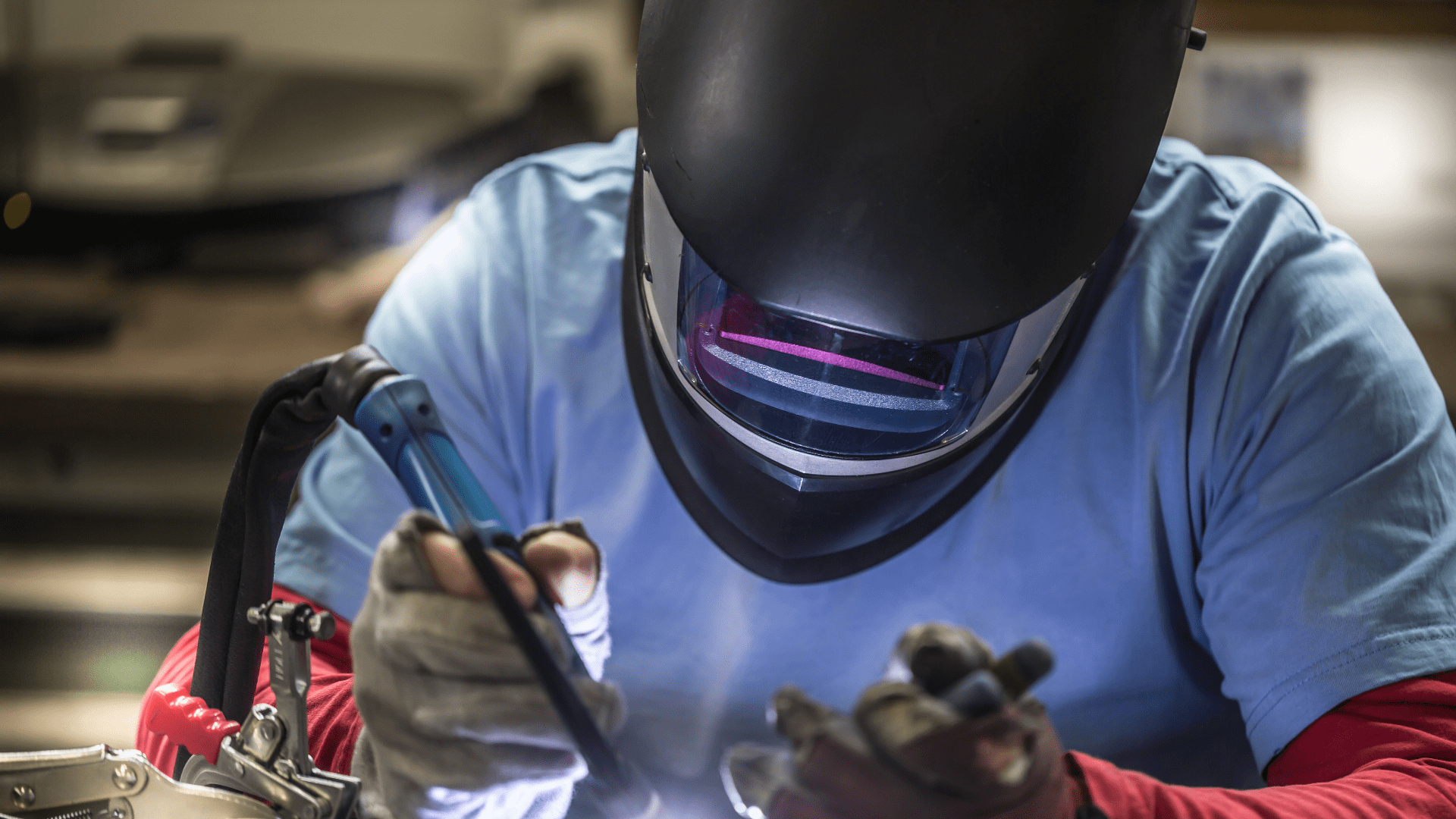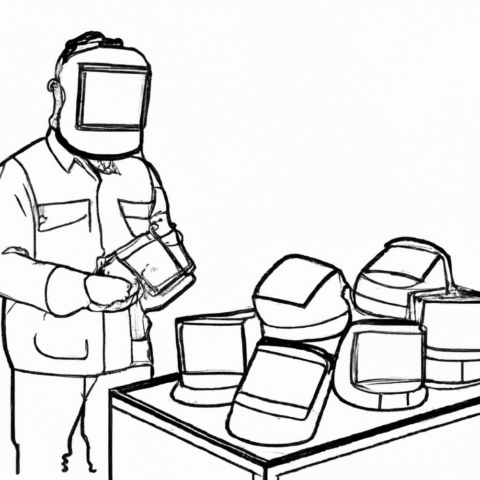Welding is a vital process across numerous industries, but it comes with inherent risks to your eyes and face due to intense light, sparks, and harmful UV/IR radiation. Welding helmets are a crucial piece of personal protective equipment (PPE) that shields you from these hazards. When selecting a welding helmet, it’s important to consider various factors to ensure your safety, comfort, and efficiency during welding tasks.
In this guide:
Huge Savings on Welding Helmets!
Check out our fantastic range of welding helmets and masks!

Understanding Your Needs
Before diving into the specifics of different welding helmet types, it’s essential to assess your individual needs and welding circumstances. Every welder’s situation is unique, and considering the following factors will guide you in selecting the helmet that best suits you:
Your Welding Applications and Environments
When considering the ideal welding helmet for your needs, it’s crucial to begin by identifying the specific applications and environments in which you’ll be working.
First and foremost, pinpoint the types of welding processes that dominate your work, such as MIG, TIG, or Stick welding. It’s essential to recognize that each welding process emits varying levels of light intensity and UV/IR radiation. This awareness will help you tailor your helmet choice to the specific demands of your chosen welding methods.
Moreover, take into account the materials you typically work with during your welding tasks. Different metals can generate distinct levels of intense light and sparks. Understanding these variations will contribute to your ability to select a helmet that adequately shields you from the specific hazards your materials may present.
In addition to the nature of your welding operations, the environment in which you work plays a pivotal role in your helmet selection. If you frequently find yourself welding outdoors, factors like natural light fluctuations must be taken into consideration. In such scenarios, helmets with additional sensitivity adjustments become essential, as they can help maintain optimal visibility despite changing outdoor lighting conditions. Conversely, if your work primarily takes place indoors, your helmet choice may differ in terms of necessary sensitivity settings.
By carefully identifying your welding applications, materials, and whether you predominantly work indoors or outdoors, you will be well-equipped to make a more informed decision when selecting a welding helmet that effectively caters to your unique requirements.
Duration, Type of Welding, and Comfort Level
When considering your needs for a welding helmet, several factors come into play. The duration of your welding sessions is a key consideration. If you find yourself often engaged in prolonged welding sessions, the comfort and weight of the helmet become crucial aspects. Prolonged use can lead to fatigue, so opting for a lightweight and comfortable helmet can significantly improve your welding experience.
Another factor to take into account is the frequency of your welding tasks. For frequent welders, features that enhance productivity and streamline the welding process can be particularly valuable. Auto-darkening helmets, for instance, eliminate the need to manually adjust the helmet when switching between welding and rest periods, making them an appealing choice for those who weld frequently.
Comfort is a central concern regardless of the duration or frequency of your welding tasks. A helmet that provides a comfortable fit is essential to prevent discomfort and fatigue, especially during extended welding periods. Helmets with adjustable headgear and well-padded interiors contribute to achieving this level of comfort. By focusing on these considerations, you can ensure that your welding helmet not only protects you but also supports your overall well-being during welding tasks.
Cost
When choosing the right welding helmet, it’s important to consider your budget constraints as a crucial factor in your decision-making process. One aspect to contemplate is the balance between your investment and the longevity of the helmet. While higher-quality helmets might carry a steeper upfront cost, they often provide better overall protection and have a longer lifespan. This initial investment can translate into enhanced safety and sustained value over time.
However, finding the right balance between your budget and the features you require is equally important. Prioritize your spending based on the specific benefits that align with your welding needs. While budget-friendly options may be tempting, remember that safety should never be compromised for cost savings. Investing in a welding helmet that meets industry standards and aligns with your requirements ensures that you’re adequately protected during your welding tasks.
By taking into account factors such as your welding applications, working environment, comfort preferences, and budget limitations, you can make a well-informed decision that not only safeguards your well-being but also enhances your efficiency and productivity while welding. As you continue reading through the subsequent sections, you’ll gain a deeper understanding of the features and considerations associated with each type of welding helmet, which will empower you to make a knowledgeable and confident choice.
Types of Welding Helmets
Welding helmets come in various types, each catering to specific needs and welding scenarios. Understanding the features and limitations of these types will enable you to choose the helmet that aligns best with your requirements.
Fixed Shade Helmets
Fixed shade helmets operate on a straightforward technology, featuring a single, unchanging shade level for the lens. They are particularly well-suited for welding processes characterized by a consistent and predictable light intensity. These helmets are commonly employed in tasks such as brazing or plasma cutting, where the brightness of the arc remains relatively stable. This fixed shade feature ensures that the lens maintains the same level of protection throughout the welding process.
One of the primary advantages of fixed shade helmets is their simplicity. They tend to be more affordable compared to the more advanced auto-darkening alternatives. This affordability can be especially appealing for welders with specific, consistent welding needs. However, it’s important to note that fixed shade helmets do have limitations in terms of versatility. Because the shade level doesn’t adapt to changing conditions, they might not be suitable for applications with varying light intensities, potentially hindering visibility and comfort during such tasks. As a result, while fixed shade helmets offer a straightforward and cost-effective solution for certain welding scenarios, they may not provide the flexibility required for a wide range of welding applications.
Auto-Darkening Helmets
Auto-darkening helmets employ lenses equipped with electronically controlled liquid crystal cells that automatically modulate their darkness level in direct response to the intensity of arc light. This technology is designed to enhance the welding experience by dynamically adjusting the level of protection provided by the helmet’s lens.
The advantages of auto-darkening helmets are noteworthy. They notably eliminate the need to constantly lift or flip the helmet during setup, ensuring a streamlined workflow. The transition from light to dark and vice versa is seamless, maintaining continuous visual contact with your workpiece. This innovation greatly improves efficiency and accuracy during welding tasks.
These helmets feature adjustable shade selection and sensitivity settings. This empowers welders to fine-tune the lens to suit various welding processes and environmental conditions. Additionally, the delay time before the lens returns to a clear state after welding can be customized, ensuring optimal visibility and comfort between welds.
When considering auto-darkening helmets, it’s crucial to evaluate the power source. Some models are powered by replaceable batteries, others incorporate solar panels, and certain helmets utilize a combination of both. Checking the battery life and charging options will help you choose a helmet that aligns with your usage patterns and preferences.
While auto-darkening helmets provide a high level of adaptability across different welding applications, they may carry a higher initial cost compared to other helmet types. However, the added convenience and versatility they offer often justify the investment for welders who frequently switch between various welding processes and lighting conditions.
Air-Fed Helmets
Air-fed helmets are designed not only to safeguard your eyes but also to provide a continuous supply of filtered air for breathing in environments where hazardous fumes and particles are a concern.
These helmets play a critical role in environments where there’s a higher risk of exposure to fumes and particles, such as confined spaces or areas with inadequate ventilation. The constant supply of clean air ensures your respiratory health remains protected, even in challenging welding conditions.
The components of air-fed helmets form a comprehensive system aimed at ensuring safety. This system includes an air source, which can be in the form of a compressor or an air cylinder, responsible for providing the filtered air. The respirator, a crucial component, filters the incoming air to prevent inhalation of harmful particles. The headgear assembly secures the helmet in place, facilitating proper fit and functionality.
Comfort during prolonged use is a paramount consideration for air-fed helmets. While these helmets are indispensable for respiratory safety, they must also be wearable for extended periods. The inclusion of adjustable headgear ensures a secure and comfortable fit, reducing strain during extended welding sessions. Properly fitted respirators prevent discomfort and ensure optimal air flow.
Air-fed helmets offer unparalleled protection in environments with toxic substances, providing a shield for both the eyes and respiratory system. However, it’s important to note that these helmets can be bulkier and more complex than other types of helmets, potentially leading to discomfort during extended use. This trade-off between enhanced protection and potential discomfort should be carefully considered when evaluating air-fed helmets for your welding needs.
Welding Masks
Welding masks offer the most basic level of face protection, consisting of a fixed shade lens affixed to a simple frame. They are characterized by their straightforward design, providing essential coverage for the eyes and face.
These masks are most suitable for occasional light welding tasks that don’t require the full coverage and features of advanced welding helmets. They provide a straightforward solution for situations where the intensity of the welding light is relatively low.
However, it’s important to note that welding masks offer limited protection when compared to more advanced helmet options. While they shield the eyes and face from some sparks and debris, they don’t provide the comprehensive protection against intense light and potentially hazardous UV/IR radiation that full helmets offer.
Given their relatively basic design, welding masks are typically used in scenarios where the welding process is less intensive or sporadic. They might find application in small-scale tasks or hobbyist projects where the need for extensive protection is limited.
When considering welding masks, it’s essential to weigh the pros and cons. On the positive side, they are cost-effective and lightweight, making them easy to use for quick welding jobs. However, their limitations become apparent in comparison to more advanced helmet types, as they lack the adaptability, comfort, and comprehensive protection provided by modern helmets.
In conclusion, welding masks serve as a fundamental option for minimal protection in select welding scenarios. While they offer simplicity and affordability, they should be carefully considered based on the specific welding tasks and environments to ensure that safety and protection are adequately prioritized.
Understanding the features and applications of each type of welding helmet will help you narrow down your options based on your specific needs and preferences. In the following sections, we’ll delve deeper into the key features to consider when selecting a welding helmet and provide additional factors to help you make an informed decision.
Key Features to Consider
When choosing a welding helmet, several key features play a significant role in ensuring both your safety and comfort during welding tasks. Evaluating these features will guide you towards selecting a helmet that aligns with your specific needs.
Variable Shade Levels: Auto-darkening helmets are equipped with adjustable shade levels, allowing you to tailor the darkness of the lens to match different welding processes. When selecting a helmet, prioritize those that offer a wide range of shades, typically falling within Shade 9 to 13. This versatility ensures that you’re prepared for various welding applications and lighting conditions.
Reaction Time: This metric indicates how swiftly the lens transitions from a clear state to a darkened one when an arc is initiated. A shorter reaction time, typically measured in milliseconds, provides superior protection against sudden bursts of intense light. Opt for a helmet with a fast reaction time to shield your eyes effectively during welding.
Sensitivity Settings: Welding environments can vary in terms of light intensity. Adjustable sensitivity settings allow the helmet to adapt to these changing conditions, ensuring the lens darkens appropriately. Seek a helmet with customizable sensitivity settings to match the specific light levels of your welding tasks.
Viewing Area Size: The size of the viewing area significantly impacts your field of vision while welding. Helmets with a larger viewing area offer better visibility of both your workpiece and the surrounding area. When choosing a helmet, consider models that provide an ample viewing space without compromising on comfort or fit.
Adjustable Headgear: Comfort is paramount during extended welding sessions. Look for helmets with adjustable headgear featuring padded straps and cushioning. This ensures a secure and comfortable fit that reduces strain on your head and neck throughout your work.
Weight and Balance: A well-balanced helmet contributes to reduced fatigue during long welding sessions. Opt for a helmet that effectively distributes its weight across your head and neck, minimizing discomfort and allowing you to focus on your work.
Battery Life: If you’re opting for an auto-darkening helmet, battery life is crucial. Check the expected battery duration to ensure it aligns with your typical welding session length. Some helmets incorporate solar panels for recharging, extending the battery’s lifespan and reducing the need for frequent replacements.
Certifications: Prioritize helmets that adhere to recognized safety standards and certifications, such as ANSI Z87.1 and EN379. These certifications validate the helmet’s ability to provide adequate protection against welding hazards. Choosing a certified helmet underscores your commitment to safety.
By carefully evaluating these key features, you can make an informed decision that suits your unique welding requirements. These features collectively contribute to a helmet’s performance and your overall welding experience. In the next section, we’ll delve into additional considerations that can further influence your choice of welding helmet.
Additional Considerations
When considering welding process compatibility, it’s essential to recognize that different welding processes emit varying levels of light and radiation. Therefore, it’s crucial to ensure that the helmet you select is well-suited for the specific processes you frequently engage in. This ensures optimal protection against the unique challenges posed by each welding technique.
For those opting for air-fed helmets to ensure respiratory protection, the filtration efficiency of the respirator component becomes paramount. Ensuring that the helmet’s respirator effectively filters out hazardous particles and fumes is vital for maintaining a safe working environment and protecting your respiratory health.
Maintenance and replacement parts play a vital role in the longevity of your chosen helmet. As time passes, components such as headgear, lenses, and filters may require replacement. It’s a wise practice to check whether these replacement parts are readily available for the specific helmet model you are considering. Additionally, considering the ease of cleaning and maintaining the helmet is especially important for air-fed helmets, where cleanliness directly impacts respiratory safety.
Warranty coverage and customer support can significantly impact your overall experience with the welding helmet. A longer warranty period offers peace of mind, assuring you that you’re covered against potential defects or malfunctions. Furthermore, opting for a helmet from a reputable brand known for reliable customer support ensures that any issues that may arise can be effectively addressed.
By taking into account these additional considerations, you’ll gain a comprehensive understanding of the practical aspects and long-term implications of your welding helmet choice. This holistic approach empowers you to make an informed decision that not only meets your immediate welding needs but also aligns with your future requirements.
Selecting the right welding helmet is a crucial decision that directly impacts your safety, comfort, and efficiency while engaging in welding tasks. Throughout this buyer’s guide, we’ve explored the diverse landscape of welding helmets, from fixed shade options to advanced auto-darkening helmets, air-fed systems, and traditional welding masks. By understanding the features, benefits, and limitations of each type, you’re better equipped to make an informed choice that aligns with your welding needs.
Remember, your unique circumstances play a significant role in guiding your decision-making process. Whether you’re a professional welder, a hobbyist, or somewhere in between, considering factors such as the welding processes you undertake, your work environment, and your personal comfort preferences will enable you to narrow down the options that best suit you.
Key features like lens shade range, reaction time, viewing area size, and comfort are critical components of your welding helmet’s performance. Additionally, taking into account welding process compatibility, respiratory protection, maintenance, replacement parts, and warranty coverage ensures a well-rounded evaluation.
Your welding helmet is more than just a piece of equipment – it’s a vital safeguard against the potential hazards of welding. By making an educated choice that combines safety, comfort, and durability, you’re investing in a tool that not only enhances your welding experience but also prioritizes your long-term well-being.
We encourage you to follow the insights provided in this guide, seek advice from experienced welders, and thoroughly research the models and brands that catch your interest. With your safety and comfort at the forefront, you can confidently embark on your welding journey equipped with the knowledge to choose a welding helmet that best fits your needs.




